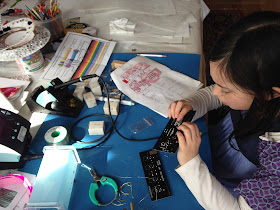Child 1 had been wanting a clock in her room for a while, to know how late it was getting when she is up reading after bedtime, and also to be able to set an alarm to get up in the morning. We could have just purchased a cheap clock from any number of retail sources, but I thought it would be a good opportunity for a project.
When the kids soldered the through hole parts into the motor driver board for our CNC woodcutter, they did a good job and had a blast doing it. So I thought if I could find a clock kit with through hole components it would present them with more parts to solder, and to a useful end.
I've always thought nixie tubes were cool, and have wanted to build something with them for a long time. I even bought some tubes from one of the ebay sellers based in Russia, but so far all they have done is moulder in my basement. Apparently the display tubes were still manufactured in Soviet factories much more recently than you would have thought, and are sitting in warehouses across the eastern bloc gathering dust. You can find many a nixie clock on ebay, so I emailed the seller of a design I admired and asked if I could pay him full price but have him send the clock unassembled, assuring him that I had the skill to deal with that and wouldn't bug him much with issues encountered building the clock. He accepted this proposal and sent us a kit form clock, with some nice instructions and even a few simple jigs for mounting the tubes. What a guy!
I think of myself in this instance as admirably practical since I decided to buy a kit, rather than feeling compelled to design the whole thing from scratch and write the embedded clock code. I hope I get some credit for choosing to not do things the hard way :). It helps that the clock is so nicely designed.
The kit sat on the shelf for like a year, until I got myself together enough to set up to do the project with the kids. Child 1, Child 2, and Child 3 all love soldering and were excited to set up the static mat and soldering tools on the dining table.
Over a couple weeks, we gradually installed all the components.
I didn't solder anything on this board, and only had to help fix a couple small problems like a backwards diode, solder bridges, and the like. I did help Child 1 identify parts and figure out assembly order and orientation, as well as the use of the tube mounting jigs.
We used lead free solder, because that made everyone feel better about the project. I must say it is harder to work with. The iron temp had to be adjusted up quite a bit, and it forms dross more easily than 63/37. The dross doesn't go away as readily with application of flux either (even though I had bought a special lead free solder flux pen). But it was not impossible, just more challenging.
Child 2 put in a few parts as well, while Child 3 was mostly interested in working with me to solder bits of brass wire together into shapes. Here is one Child 2 did with me as a present for a friend's brithday.
I printed out the resistor color code and Child 1 used it to figure out which resistors were which.
Probably I lost them while shuffling the kit parts around, but we found ourselves short a 4MHz quartz crystal, the wall power adapter, and the case screws at the end of the assembly. The crystal and adapter were easily sourced from Digi-Key and I borrowed a couple screws from work for the case.
We tested out the board in stages, as directed by the instructions, and everything worked fine (after I actually understood the way the UI worked).
The clock is beautiful and works well. Child 1 is super pleased with the clock, and herself for building it.
Only minor quibble is that it is awful bright in a dark room even at the lowest brightness setting. A photo cell and auto brightness adjust would be a nice addition for a future version. The PIC that is running the clock is more than maxed out on pin usage, but perhaps a bigger chip or an external MUX could be used to address that. At minimum a few more clicks on the low end of brightness range would be great.
I love how the blue LEDs are positioned so they shine up into the sealing area in back of the tubes, such that the LED output is light piped around the tubes by the glass envelope. Brilliant!
Child 1 is happy, and Child 2 wants to build one for her and Child 3's room too.












Very cool. the tubes from Russia remind me of projects with Kevin in Tehachapi years ago. Such good skills the girls are learning, and soldering is fun!
ReplyDeleteWonderful post Holly -- I wonder if you every saw my "steel winds" meter using two old Burroughs Nixie's -- they are the biggest Nixie's I have seen and have never seen them listed on Ebay or anywhere else. they are horizontal and 2 inches in diameter.
ReplyDeleteIll send you a video if your interested.
Kevin c
Thanks for the comments guys. Kevin, I don't recall seeing your huge tube nixie clock - those tubes sound awesome! I'd like to see your video if you have it handy to send me.
ReplyDelete